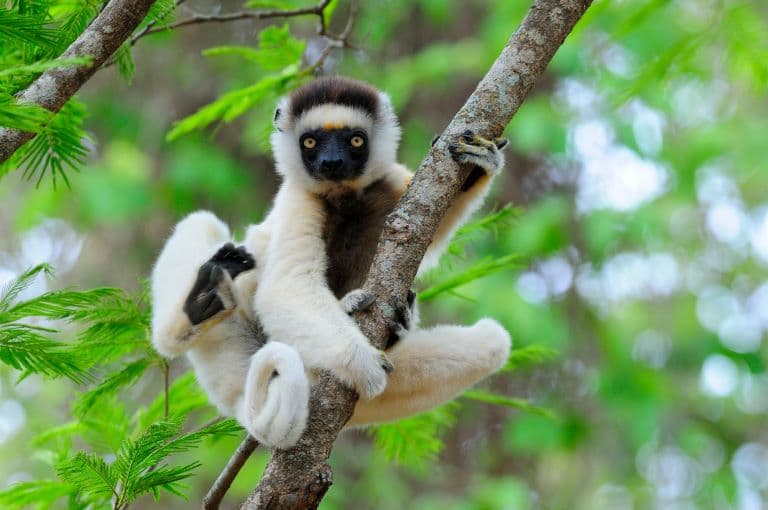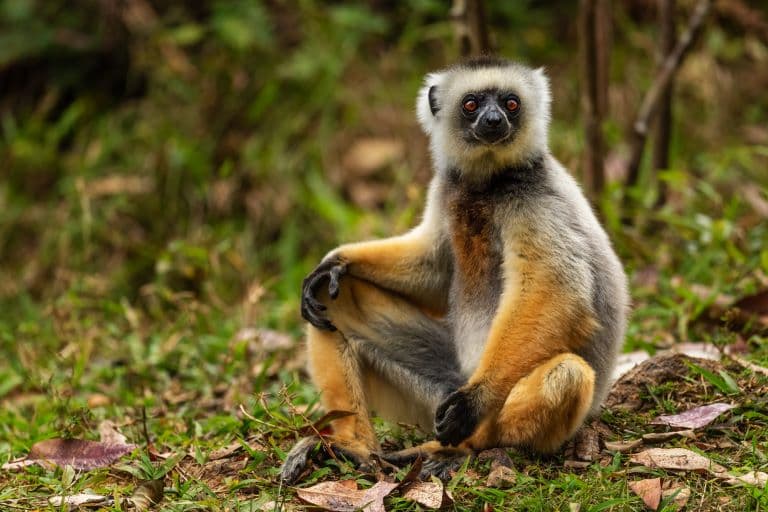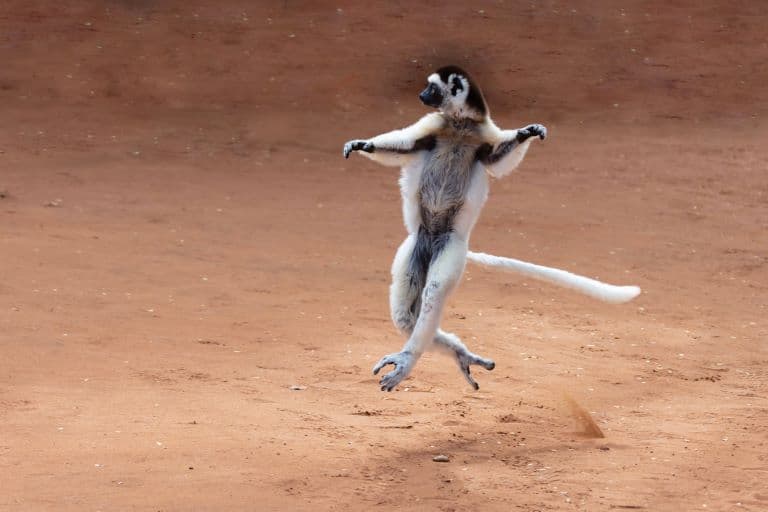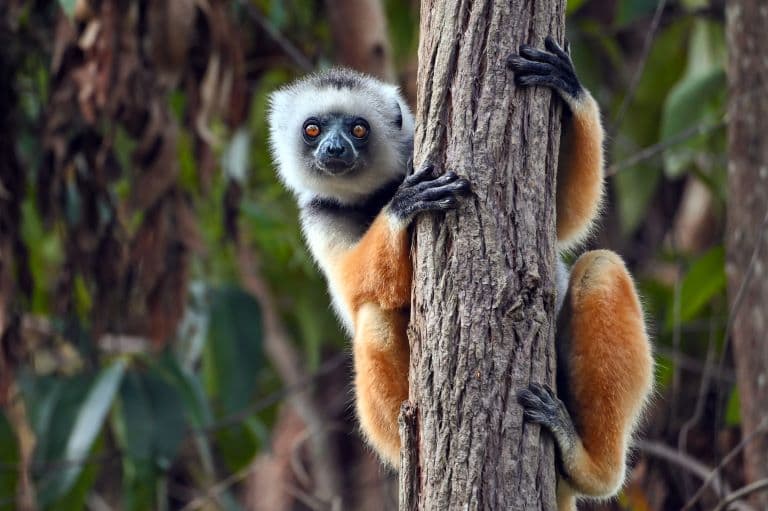Sifaka Profile
The ever-decreasing rainforests of Madagascar are home to primates found nowhere else on Earth, and with them comes a unique soundscape that might be just as appropriate in a Lost World movie.
The calls of the largest lemurs, the Indris, echo trumpet-like across the island, and just slightly smaller are their closest relatives, the Sifakas, yelling a recognisable call of “Shi-Fak”; the sound that gave them their names.

Sifaka Facts Overview
| Habitat: | Forest; from sub-humid rainforest to dry deciduous forest |
| Location: | Madagascar |
| Lifespan: | 27 to 31 in the wild |
| Size: | 55 cm (22 in) |
| Weight: | 6 kg (13.2 lb) |
| Colour: | Varied, often black and white with reds and browns |
| Diet: | Leaves, seeds, fruits, flowers, and buds, sometimes soil |
| Predators: | Fossa, snakes, humans |
| Top Speed: | 30 km/h (18 mph) |
| No. of Species: | 9 |
| Conservation Status: | One species is Endangered, and the remaining 8 Critically Endangered (IUCN) |
Sifakas are medium-sized lemurs, making up nine (and the majority of) species in the Indri family. Unlike the indris, though, they have long tails and supreme arboreal agility.
These tree specialists do come to the ground occasionally, but their dancing gait shows they’re not really built for it.
They have a handful of quirky behaviours and adaptations that make them stand out, but sadly these have not been enough to stem the tide of human destruction that now sees all but one species listed as Critically Endangered, and the last one is not far behind.
Interesting Sifaka Facts
1. They’re Indrids
Indris are the largest of the lemurs, and have a lot of similarities with the Sifakas, in large part because they’re from the same family.
Indriidae is a slightly misleading name for this family, as it contains the one species of Indri, the largest lemur in the family, and around 18 other species of lemur in two more genera.
Half of these are the tiny, woolly lemurs, and the other half are the sifakas, that sit somewhere in between the two on the size scale.
Another distinctive difference between the Indri and the Sifakas is the presence of a tail. Indris have just a stump, whereas the sifakas have a glorious appendage, sometimes longer than their body. 1

2. They’re agile
As you might expect from an animal with such an impressive tail, these are real professionals in the trees. Faced with frightening predation from both fossas and large raptors, they escape being eaten by engaging in arboreal acrobats in the branches.
A sifaka can move through the canopy at speeds of up to 30 km/h, although this isn’t always enough to dodge predators. When cornered they will bite and scratch, and have been witnessed attacking and fending off a Madagascar ground boa.
Terrestrially, they’re not quite as adept. Their long limbs mean they have to prance about to move across the ground, which makes for fun watching. 2

3. They eat soil
While they’re down there, sifakas engage in the unusual pastime of geophagy, or eating soil.
This is something human people do on occasion and are rightfully judged for it, but the difference here is that sifakas do it to gain minerals that they might not have access to from their leafy diet.
One other benefit of eating soil that has been hypothesised is that it can provide certain enzymes associated with the breakdown of cellulose – the strong carbohydrate that protects plant cells. This might explain why they tend to eat termite soil.
This behaviour is seen more often in generalised leaf eaters, and less so in the specialist species. The golden-crowned sifaka doesn’t appear to do it at all but is the only species that isn’t known to.
4. Toilet claw
Another quirk that lemurs present with and humans get shunned for is the toilet claw.
Despite the name, this is less of a poop knife and more of a nit comb, which is usually found on the second toe of the sifaka’s foot and is used to scrape off parasites and dirt off their fur and possibly pick bits of fluff out of their belly buttons.
Another cool adaptation is the presence of a tooth comb, which is the name for a specialised set of lower incisors, elongated and closely spaced
The tooth comb, on the other hand, is formed by the lower incisors, which are elongated and closely spaced.
This is known to be used in grooming, but there is a chance it can also be used to spread toxic saliva through the fur to deter predators.
This hasn’t been confirmed in sifakas but is the case with some closely related lemur species, who also chew on millipedes to make use of the toxic secretions they produce.
5. Silky Sifaka
All this grooming apparatus sincerely helps with the appearance, and the silky sifaka is possibly the best-dressed of them all.
They also have the best rapper name of any lemur species but are still relatively poorly understood. Silky sifakas don’t survive in captivity, and even in the wild, things are hard.
More than half of baby silkies don’t make it past one year, on account of predation and infanticide by other males, as well as the stress of habitat loss.
This is a common theme for all sifaka species, with the vast majority (all but one) species being listed as Critically Endangered, and the last one not far behind. 3

6. The Fossa
Habitat loss is the most pressing issue for the species, but sifakas are faced with one of the coolest Madagascan predators, too.
The fossa is the size of a medium-sized dog and is a very stealthy and ferocious carnivore. It’s so elusive that conservationists are struggling to study it, but this is Madagasca’s largest predator and skulks around like a cat, feeding on lemurs like the sifakas.
It’s actually a relative of the genet, a cat-like viverrid, and grows to about 1.5 metres long. This would be the major threat to the Sifakas without habitat destruction, but the ecological balance would mean the species was still stable as a whole.
Unfortunately, that’s not how things are working out. 4
7. But humans are the main issue
Traditionally, many African cultures across the continent have “taboos”, or items that are forbidden. It’s thought this is a rudimentary form of conservation, a way of avoiding the over-exploitation of species so that they continue to thrive.
Once, these taboos would have gone some way to protecting the lemurs on Madagascar, but encroaching agriculture is wiping out their habitats, and slash-and-burn activities are permanently removing the forests.
And as communities mix, taboos are being respected less. Sifakas are hunted on the ground when they come down to drink, and populations are becoming smaller.
Unfortunately, all lemurs, including the sifakas, are now in serious trouble. 5

Sifaka Fact-File Summary
Scientific Classification
| Kingdom: | Animalia |
| Phylum: | Chordata |
| Class: | Mammalia |
| Order: | Primates |
| Family: | Indriidae |
| Genus: | Propithecus |
Fact Sources & References
- Tanya Dewey “Indriidae indris, sifakas, and relatives”, Animal Diversity Web.
- happyspider (2015), “Dance of the Sifakas”, YouTube.
- Lorraine Negron, “Propithecus edwardsi Milne-Edward’s sifaka”, Animal Diversity Web.
- “A cougar-like predator is attacking lemurs in Madagascar. Both are in jeopardy and scientists don’t know what to do”, discover wildlife
- “Coquerel’s Sifaka”, IUCN Red List.
